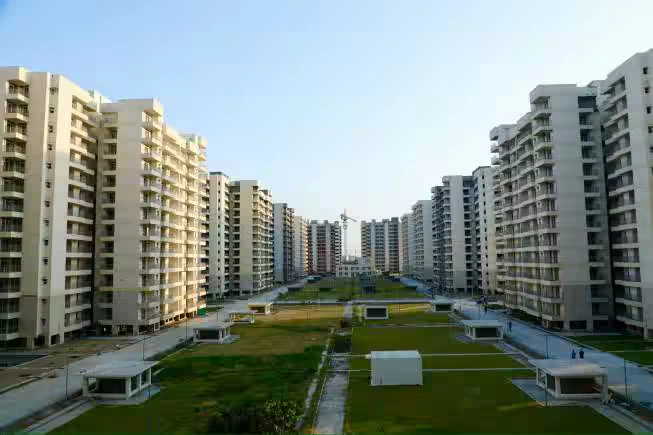Table of Content
The housing market in Tier 1 cities, a key indicator of India’s real estate health, slowed down a bit in FY25. As per India Ratings and Research (Ind-Ra), volume of housing sales by the largest residential developers fell 6% year-on-year. The decline shows a correction in the residential real estate cycle relative to the high growth of FY23 and FY24.
Decline in Housing Sales Volume
The report showed a 6% decline in sales volumes in FY25, driven by a significant 13% year-on-year decrease for just the fourth quarter. This activity will likely be partially attributed to a strong base effect of previous years combined with the timing of project starts. Of the 11 listed developers reviewed by Ind-Ra, 4 reported a large decrease in pre-sales volumes in the quarter.
Also Read: Housing Supply in Tier-2 Cities Sees a Major Cooldown in Q1 2025: What's Behind the 35% Drop?
Contrasting Growth in Sales Value
Even with a reduction in volumes, the value of sales of residential properties in FY25 by Tier 1 developers rose by 9% y/y. This upward motion was aided by better realizations and a more favorable sales mix as more premium and high-value residential properties transacted. Re-alignment of pricing helped to mitigate this dip in overall sales volume.
Projections for FY26
Ind-Ra predicts a moderation in booking value growth for FY26 compared to the 23% year-on-year rise observed in FY25. The agency expects low-to-mid single-digit growth, citing the high base effect from FY22 to FY25. Key factors that could influence growth in FY26 include:
- Sector Consolidation: Ongoing consolidation among developers is likely to sustain demand.
- Policy Measures: Recent initiatives, including interest rate cuts, may bolster affordable and mass-market housing segments.
- Resilient Demand: The mid-premium segment is expected to remain a strong performer, supporting moderate growth.
Key Drivers Behind the Decline
Several factors contributed to the decline in housing sales volumes:
- High Base Effect: Exceptional growth in FY22–FY24 created a challenging benchmark for FY25.
- Delayed Project Launches: Developers faced setbacks in initiating new projects, impacting sales momentum.
- Macroeconomic Conditions: Broader economic factors may have influenced buyer sentiment.
Strength of the Mid-Premium Segment
The mid-premium housing segment remains a key pillar of the Tier 1 cities realty. An established mid-premium segment enables buyers to access some degree of affordability and luxury at the same time. Overall the mid-premium housing segment has lasted with remarkable durability. Consumer demand is confirmed by government policy and by increased transparency from the sector dedicated to mid-premium housing.
Also Read: Godrej to Build 16-Acre Premium Project in Upper Kharadi, Pune
Expert Insights
Mahaveer Shankarlal Jain, Director of Corporate Ratings at Ind-Ra, noted:
"The residential real estate cycle is likely to be moderating due to the high base effect and delays in launches. The recently announced cut in interest rate could serve as a strong tailwind, especially for the affordable and mass segments, and is likely to support the mid-single digit growth in FY26 bookings."
Jain also reiterated that the better product mix and better realizations have curtailed the volume decline to some extent, but the value growth has been retained.
Conclusion
The decline in sales volumes among Tier 1 developers indicates a turning point in motion within the residential real estate market. Yet, the increase in sales values and endurance within the mid-premium category also reflected the spatial market’s adaptability. Given the high base effect, along with the changing environment, we believe that FY26 can be a cautiously optimistic tale for developers moving forward.
Tier 1 cities still hold promise for prospective buyers and investors, across segments, with opportunities that offer affordability and value. Given the evolving policy environment, with supportive measures and sustained levels of demand, growth in the market is anticipated to grow in a steady, albeit moderated way, as we move into the next year.
Follow AquireAcers Whatsapp Channel to Stay Updated With The Latest Real Estate News







Ans 1. The 6% decline in housing sales volume in FY25 was primarily attributed to a high base effect from the significant growth seen in FY22–FY24, delays in new project launches by developers, and broader macroeconomic conditions affecting buyer sentiment.
Ans 2. No, despite the decline in sales volume, the overall sales value rose by 9% year-on-year in FY25. This increase was driven by better pricing realizations and a shift toward more premium and high-value residential properties.
Ans 3. Ind-Ra forecasts moderated growth in booking values for FY26, with expectations of low-to-mid single-digit growth. Key factors influencing this outlook include ongoing sector consolidation, recent policy measures such as interest rate cuts, and sustained demand in the mid-premium housing segment.
Ans 4. The mid-premium housing segment remains a critical driver in Tier 1 cities. It offers a balance of affordability and luxury, appealing to a broad range of buyers. This segment has shown remarkable resilience, supported by government policies and increased transparency in the real estate sector.
Ans 5. Delayed project launches have disrupted the sales momentum, contributing to the overall decline in housing sales volume in FY25. Developers faced challenges in initiating new projects, which affected the availability of inventory for buyers.
Ans 6. Recent policy measures, including interest rate cuts, are expected to positively influence the affordable and mass-market housing segments. These measures could serve as a catalyst for moderate growth in bookings during FY26.
Ans 7. The sector has adapted by focusing on a better product mix and enhancing pricing realizations. This approach has helped mitigate the impact of volume declines, resulting in an overall increase in sales value.
Ans 8. Developers may face challenges such as sustaining growth amid a high base effect from previous years, managing project launch timelines, and navigating macroeconomic uncertainties that could affect buyer confidence.